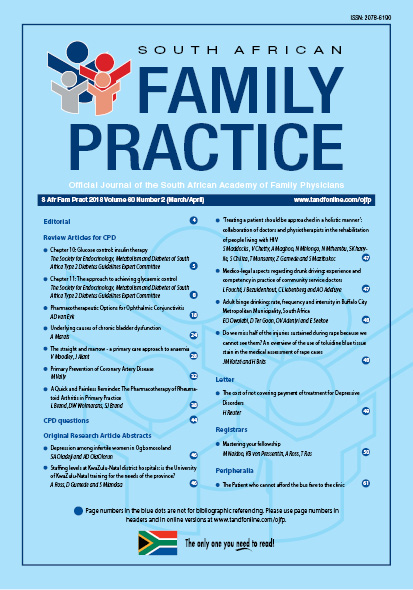Do we miss half of the injuries sustained during rape because we cannot see them? An overview of the use of toluidine blue tissue stain in the medical assessment of rape cases
Keywords:
examination, rape, sexual assault, tissue stain in vivo, toluidine blue
Abstract
The prosecution of rape cases is difficult due to the absence of eyewitnesses. McCauley found that the detection of vaginal lacerations increased from one in 24 to 14 in 24 in reported adult rape cases when toluidine blue was used. Proof of injuries consistent with sexual penetration adds significantly to the evidentiary value of the medico-legal testimony. Although rape is not a clinical diagnosis and there are no diagnostic criteria to confirm rape, the possibility of genital injury during rape far exceeds the possibility of injury with consensual intercourse. If a complete examination, including the use of toluidine blue, is not used a rapist may walk away to rape again, while the victims remain with the stigma that they may have made a false allegation. Toluidine blue is a basic thiazine metachromatic dye. It has a high affinity for acidic tissue components, thereby staining tissues rich in DNA and RNA. The epithelium of the external genitalia does not have nucleated cells and prevents contact of stain with nuclei. Where the epithelium is damaged and the underlying nucleated cells are exposed, the nuclei stain blue. Injuries sustained during genital penetration show a distinctive distribution. Toluidine blue stain is easy and safe to use, available, inexpensive and does not interfere with other medico-legal evidence, therefore it is recommended to be used in the examination of all cases of alleged rape. (Full text of the research articles are available online at www.medpharm.tandfonline.com/ojfp) S Afr Fam Pract 2018; DOI: 10.1080/20786190.2017.1386868
Section
Research Articles
By submitting manuscripts to SAFP, authors of original articles are assigning copyright to the South African Academy of Family Physicians. Copyright of review articles are assigned to the Publisher, Medpharm Publications (Pty) Ltd, unless otherwise specified. Authors may use their own work after publication without written permission, provided they acknowledge the original source. Individuals and academic institutions may freely copy and distribute articles published in SAFP for educational and research purposes without obtaining permission.

